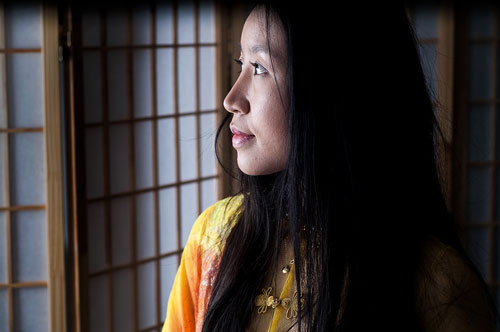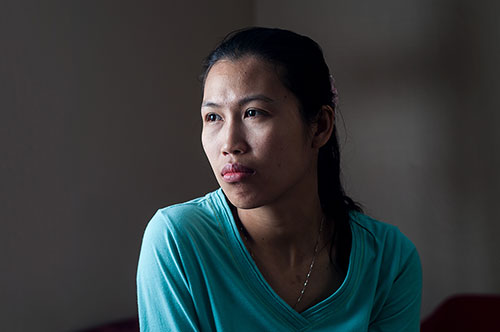Powerful exhibit, artist presentation addresses refugee immigration
October 29, 2019
By Mike Killeen


Photo media artist James A. Bowey doesn’t view refugee immigration as a political issue.
“I consider it a human issue,” Bowey said.
Bowey’s exhibit, “When Home Won’t Let You Stay,” makes it a human issue. He presents rich portraits and compelling stories of 18 refugees who came to the U.S. to make a new life.
The exhibit runs through Dec. 6 at the Benedict and Dorothy Gorecki Gallery and Lounge in the Benedicta Arts Center at the College of Saint Benedict. It’s free and open to the public and is part of the Visual Arts Series at CSB and Saint John’s University.
“We are very excited to have this photography exhibition accompany Bowey’s upcoming presentation at our institutions,” said Jill Dubbeldee Kuhn, Fine Arts Programming gallery manager. “With very little discussion, our campus partners (Gender Studies Department, CSB/SJU Libraries, Asian Studies Department, CSB/SJU Honors Program, Mellon Grant Becoming Community and Intercultural and International Student Services) enthusiastically agreed we needed to bring the entire experience - the art and Bowey’s presentation to our campuses and community.”
The program, narrated by gifted storyteller Bowey, is the most powerful component in truly building an understanding about life as a refugee. It will be held at 7:15 p.m. Nov. 7 at room 204, Gorecki Dining and Conference Center, CSB. Prior to Bowey’s talk, a light reception outside the Gorecki Gallery will be held from 6-7 p.m. Both are free and open to the public.
“It’s not your average artist talk; it’s a life-changing experience,” added Dubbeldee Kuhn.
Bowey, a former journalist and professor at Winona State University, is not trying to sway public opinion.
“The real important part here is that this is not some activist who’s coming to town trying to make a particular point or stir up a particular point,” Bowey said. “Rather, what I’m trying to do is I’m presenting stories, and by putting stories in context we let that experience of another person’s story inform the way we can feel about refugee resettlement.
“I’m not here to make anybody feel a certain way. I’m here to present the stories of the refugees, but I trust when we really listen to someone else’s story, and when we engage them empathetically, that creates the space for good reasoning, and good determination about who we want to be as a community, and who we want to be as individuals.
“Even if they don’t think they’re interested in the subject of refugees, or they’re somehow concerned about that issue, they should come,” he added. “I think people walk out of it feeling energized about human connection, as opposed to depressed about refugees. It’s a program about finding our human connection.”
Bowey was asked how he found refugees to interview and photograph.
“I would be out, and found people in every way you can, as journalists do,” he said. “I met people through social service agencies that were working with refugees, but I also found them through talking with people and getting introduced to people. There’s one person who is in the exhibition who I literally met on a street corner in Chicago.
“I’m a big believer of when there’s someone who has a story to tell and there’s someone that wants to hear it, they have a way of finding each other. I’ve always lived by that ethos, how stories connect us.”
This is the second time in just over a year that Bowey has staged the exhibit in the St. Cloud area, although each exhibit is customized to the particular location, Bowey noted. The Paramount Center for the Arts featured the exhibit in August 2018, and one of the people who saw it and realized the value of the presentation was Dubbeldee Kuhn.
“I want to acknowledge and pay tribute to the Paramount for bringing it to St. Cloud in the first place and presenting the opportunity for many of us in the community to see it,” Dubbeldee Kuhn said.
“The thing I would like people to see is that nobody wants to leave their home,” she said. “But many refugees have no choice due to political unrest or their families being threatened or killed. Often times, they leave with only what they can carry or the clothes on their back. Who would choose that?
“I think that the way (Bowey) presents it is to build empathy and to remove the barrier between us and them, and that it’s we. We’re all human, we all have a story,” Dubbeldee Kuhn said.
Bowey, who has presented dozens of the exhibitions around the country, said the exhibit does best with word-of-mouth advertising.
“There was a strong feeling among visitors to the Paramount exhibition that while it was really successful, even more people need to see it,” Bowey said.
During the exhibit, there will be an opportunity to leave messages on a “Story of Us” wall. In addition, a conversation area is in the middle of the gallery, providing viewers an opportunity to digest and discuss what they have seen.
“There is a lovely quote in James’ artist statement: ‘One of the most difficult things a person does is to truly see another,’ ” Dubbeldee Kuhn said. “ ‘But if we really look at someone and consider their story, we discover the shared humanity that links us all. That is the hope for this work – to find ourselves in each other one photograph at a time.’ ”
Hours for the Gorecki Gallery are from 10 a.m. to 9 p.m. Tuesday through Saturday (closed during CSB/SJU Thanksgiving Break Nov. 27-Dec. 2).
